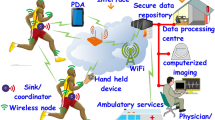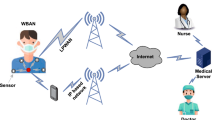Abstract
Wireless Body Area Network (WBAN) is expected to play an important role in supporting medical and healthcare services with increased convenience and comfort. One main advantage of WBAN is that it enables automatic biosignal collection in real time which is essential in medical treatment and healthcare vigilance. To harmonize with the strong demands from both medical and healthcare societies, and information and communications technology industries, IEEE 802 Standard Committee set up a task group of TG15.6 to develop an IEEE wireless standard on WBAN. In this paper, we first review the main activities of TG15.6 with the updated status. Then, we present a prototype WBAN system that is implemented by using ultra-wideband technology. Multi-hop mechanism is adopted to guarantee reliable connection. Finally, we describe an experimental system that uses the developed WBAN system by combining with satellite communication in supporting remote medical treatment and healthcare. In case of less of medical resources such as in emergency, in rural or isolated areas, such a system is important in sending the corresponding biosignal to a remote hospital in real time to help patient management. The relative delay of WBAN data delivery via satellite is measured which is dependent on the satellite link capacity.
Similar content being viewed by others
References
Li, H.-B., & Kohno, R. (2007). Introduction of SG-BAN in IEEE 802.15 with related discussion. Conference Record, ICUWB2007, Singapore, Sept 2007.
Li, H.-B., Zhen, B., Hara, S., Ikegami, T., Takada, J.-I., & Kohno, R. (2008). Prospective directions for TG6 by considering different dimension parameters, 15-08-0528-01-0006, July 2008.
Li, H.-B., Schwoerer, J., Yoon, Y.-M., Farserotu, J., Yang, W.-B., Sayrafian, K., Miniutti, D., Lewis, D., & Gowans, A. (2008). IEEE 802.15.6 regulation subcommittee report, 15-08-0034-10-0006, Sept 2008.
Lewis, D. (2008). 802.15.6 Call for applications—response Summary, 15-08-0407-05-0006, Nov 2008.
Yazdandoost, K.-Y., & Sayrafian, K. (2008). Channel model for body area network (BAN), 15-08-0780-01-0006, Nov 2008.
Zhen, B., Patel, M., Lee, S. -H., Won, E. -T., & Astrin. A. W. (2008). TG6 technical requirement document (TRD), 15-08-0644-09-0006, Nov 2008.
Siwiak K., McKeown D. (2004) Ultra-wideband radio technology. John Wiley & Sons, Ltd., England
Graichen F., Arnold R., Rohlmann A., Bergmann G. (2007) Implantable 9-channel telemetry system for in vivo load measurements with orthopedic implants. IEEE Transactions on Biomedical Engineering 54(2): 253–261
Wakana H., Li H. -B., Miura A., Nirei Y., Arakida M. (2002) Airborne and Ka-band satellite communications in a disaster management system. Space Communications 18(3–4): 157–166 (IOS Press)
Author information
Authors and Affiliations
Corresponding author
Rights and permissions
About this article
Cite this article
Li, HB., Takahashi, T., Toyoda, M. et al. Wireless Body Area Network Combined with Satellite Communication for Remote Medical and Healthcare Applications. Wireless Pers Commun 51, 697–709 (2009). https://doi.org/10.1007/s11277-009-9765-5
Published:
Issue Date:
DOI: https://doi.org/10.1007/s11277-009-9765-5




